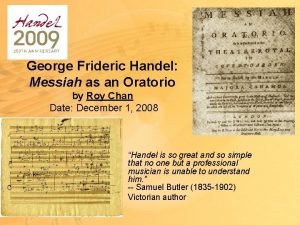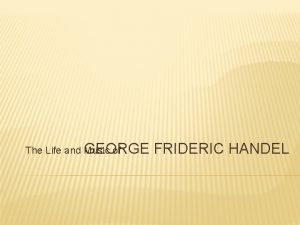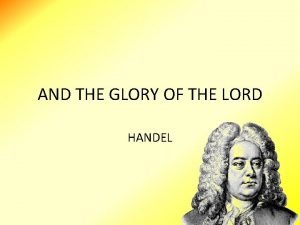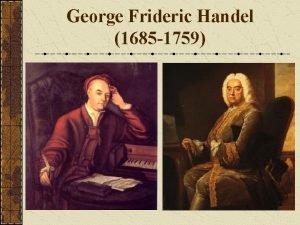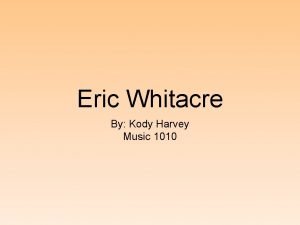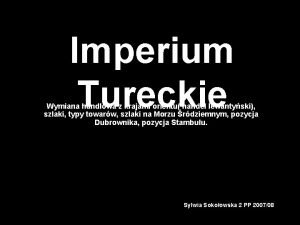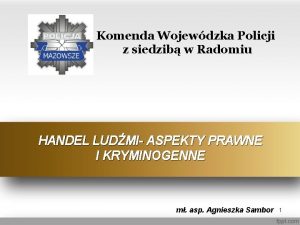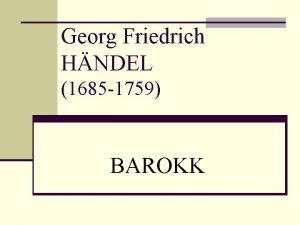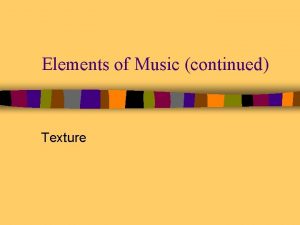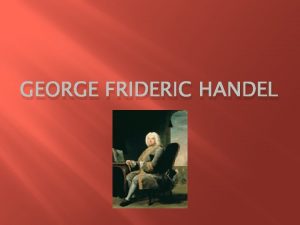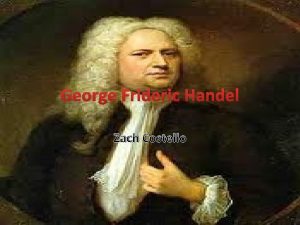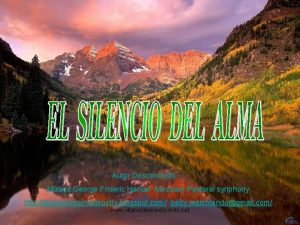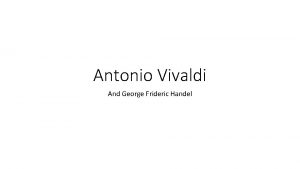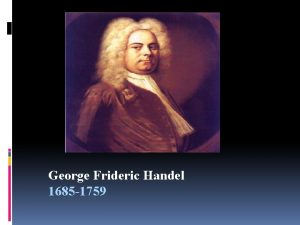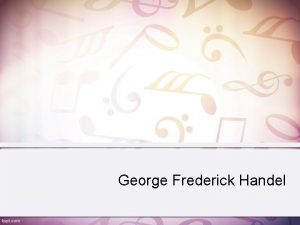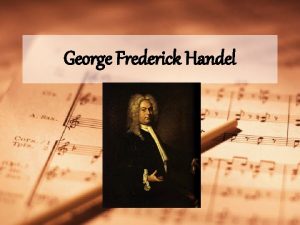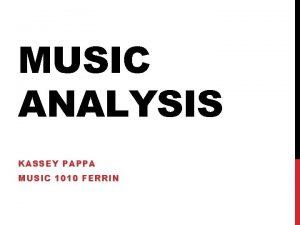GEORGE FRIDERIC HANDEL HALIE ALEXANDER MUSIC 1010 INTRODUCTION















- Slides: 15

GEORGE FRIDERIC HANDEL HALIE ALEXANDER MUSIC 1010

INTRODUCTION • George Frideric Handel • 1685 - 1759 • Studied in Germany, Italy, and England. • Known for operas and his oratorios.

BIOGRAPHY • Born February 23, 1685 in Germany. • Father against his music studies. • Studied Organ under Zachow. • Produced many compositions in youth. • Harpsichordist in Hamburg Opera (1703).

BIOGRAPHY • Composed first operas by 1705. • Almira was a successful opera • Invited to Italy by Ferdinando de’ Medici • Moved to London in 1710 • Commissioned by King’s Theater

BIOGRAPHY • Offered position at Royal Academy of Music • Left Academy and started his own • Left Italian Operas, wrote Oratorios • Composed famous oratorio: Messiah

BIOGRAPHY • Handel suffered health issues. • Held benefit concert at Hospital. • Died on April 14, , 1759. • Left estate to others.

COMPOSITION HISTORY • Messiah • “Hallelujah” • “For Unto Us A Child Is Born” • “Ev’ry Valley Shall Be Exalted”

COMPOSITION HISTORY • Commissioned by Dublin’s Lord Lieutenant • Based off Charles Jennens’s libretto • Unlike Handel’s other Oratorios • Finished composition in 24 days. • Debuted in 1742 in Dublin

LISTENING GUIDES • “Hallelujah” • Length: 4: 23 • Oratorio • Strings and Voice

0: 00 Introduction 0: 10 Chorus 0: 30 Verse 0: 56 Verse 1: 05 Verse cont. 1: 30 1: 40 bridge Bridge cont 1: 50 Bridge #2 2: 18 verse 2: 48 verse Starts with just the strings playing the Hallelujah Theme and woodwinds playing the underlying harmony, modest sounding – not very loud. We will call this rhythm A. Chorus joins in singing hallelujah – rhythm A (dotted quarter followed by 3 8 th notes) All voices and strings are in unison playing/singing the melody. This is very powerful and the dynamics are loud. We will call this rhythm B. (half note, 2 quarter notes, 3 8 th notes, 8 th rest, 2 8 th notes, 2 half notes) Soprano voices sing the melody in this verse – several layers of voice. The strings continue the same pattern – rhythm B is still played. Brass comes in playing the Hallelujah rhythm forte – two 16 th notes followed by two 8 th notes. This is rhythm C Tempo slows and the dynamic is very quiet Tempo is still slower but the crescendo to ff and we hear percussion mapping out the downbeat New Theme: “He shall rain forever and ever. ” Instruments drop in volume again, more legato as opposed to the rhythmic staccato before. The off-beat is pronounced. 3 beats rest for the instruments while altos sing “King of Kings” then instruments and vocals come in to play rhythm C This theme of women singing “King of Kings” then instruments and

LISTENING GUIDE • “For Unto Us A Child Is Born” • Length: 4: 14 • Oratorio • Strings and vocals

0: 00 Introduction 0: 16 chorus 0: 30 chorus 1: 03 verse 1: 33 chorus 2: 00 chorus 2: 32 verse 3: 00 Chorus Stings alone establish an upbeat tempo while violins have the melody, lower strings have the harmony. The song in written is major form. Style is staccato, starts with the female, alto and soprano singers. Establish rhythm A – one quarter note, 8 8 th notes) Continuation of this chorus but establishes rhythm B – 2 8 th notes, one quarter note, quarter rest, 8 th rest, 5 8 th notes, whole thing repeated. Texture becomes polyphonic when a round starts with the male vocal parts. Strings and instrumentals are very quiet while vocals establish new rhythmic theme C. Dynamics drop dramatically “unto us a child is born” theme is repeated only for a couple bars. Stings (violins) are forte at this point playing straight 16 th notes while the all the vocals sing in the same rhythm. The female upper registers have the melody while the male, lower registers have the harmony. Rhythmic theme C is repeated by forte male tenors then traded to the altos and sopranos – all the while, instrumental are merely playing rhythmic 8 th notes and not featured with the melody. “For Unto Us A Child is Born” theme repeated, being traded off from male to female vocalists, stings are

LISTENING GUIDE • “Ev’ry Valley Shall Be Exalted” • Length: 3: 48 • Oratorio • Strings and Solo Voice

0: 00 Intro 0: 23 chorus 0: 53 chorus cont 1: 23 verse 1: 50 chorus 2: 20 chorus 2: 46 bridge Upper strings have the Melody, very loud and forceful. The lower strings have the underlying harmony that has a different rhythm. The piece is in major form. Instruments rest, male solo joins in with melody, strings echo him with upper strings having the melody. Strings phrase with the use of dynamics slightly more than solo voice. They use the rhythm of one 8 th note, one quarter, with a slight emphasis on the quarter, growing a little louder each time. Now solo voice uses dynamics switching off each phrase (the same phrase repeated) one loud then soft, the strings echo him. Again, instruments rest, solo sings “Ev’ry Valley” and crescendos slightly as he finishes the phrase. Strings echo the rhythm of the vocals. The instruments seem to finish his phrase with and 8 th note followed by a quarter note. Soloist sings “exalted” emphasizing the offbeat with a higher note and a litter bit higher volume. The strings emphasize the downbeat in rhythmic unison while they play in harmony. The strings are now playing legato – the melody is sort of ambiguous here as the soloist sings 6 of the

BIBLIOGRAPHY "George Frideric Handel. " Biography. com. A&E Networks Television, 29 Apr. 2016. Web. 07 Dec. 2016. "George Frideric Handel. " Wikipedia. Wikimedia Foundation, n. d. Web. 07 Dec. 2016. "Messiah (Handel). " Wikipedia. Wikimedia Foundation, n. d. Web. 07 Dec. 2016.
 George frideric handel facts
George frideric handel facts George frideric handel birth
George frideric handel birth George frideric handel compositions
George frideric handel compositions George frideric handel and the glory of the lord
George frideric handel and the glory of the lord George frideric handel (1685-1759)
George frideric handel (1685-1759) Online music portfolio
Online music portfolio Eric whitacre bio
Eric whitacre bio Alexander friedmann and george lemaitre
Alexander friedmann and george lemaitre Alexandru ioan cuza
Alexandru ioan cuza George kelly kişisel yapılar kuramı
George kelly kişisel yapılar kuramı Formidlingsaftale løbetid
Formidlingsaftale løbetid Handel lewantyjski
Handel lewantyjski Hdi nackdelar
Hdi nackdelar Handel dziećmi
Handel dziećmi Händel
Händel Messiah hallelujah texture
Messiah hallelujah texture
